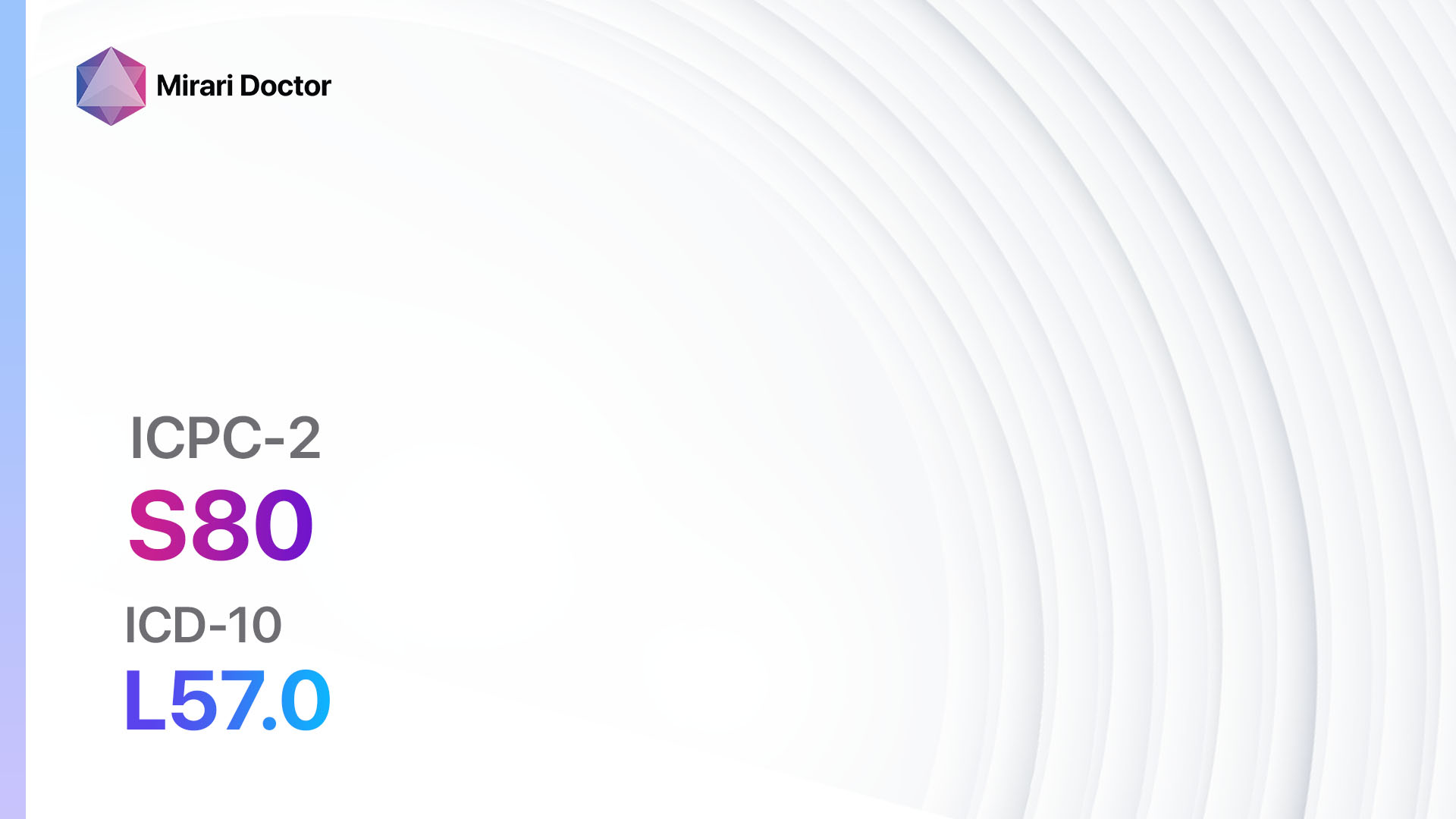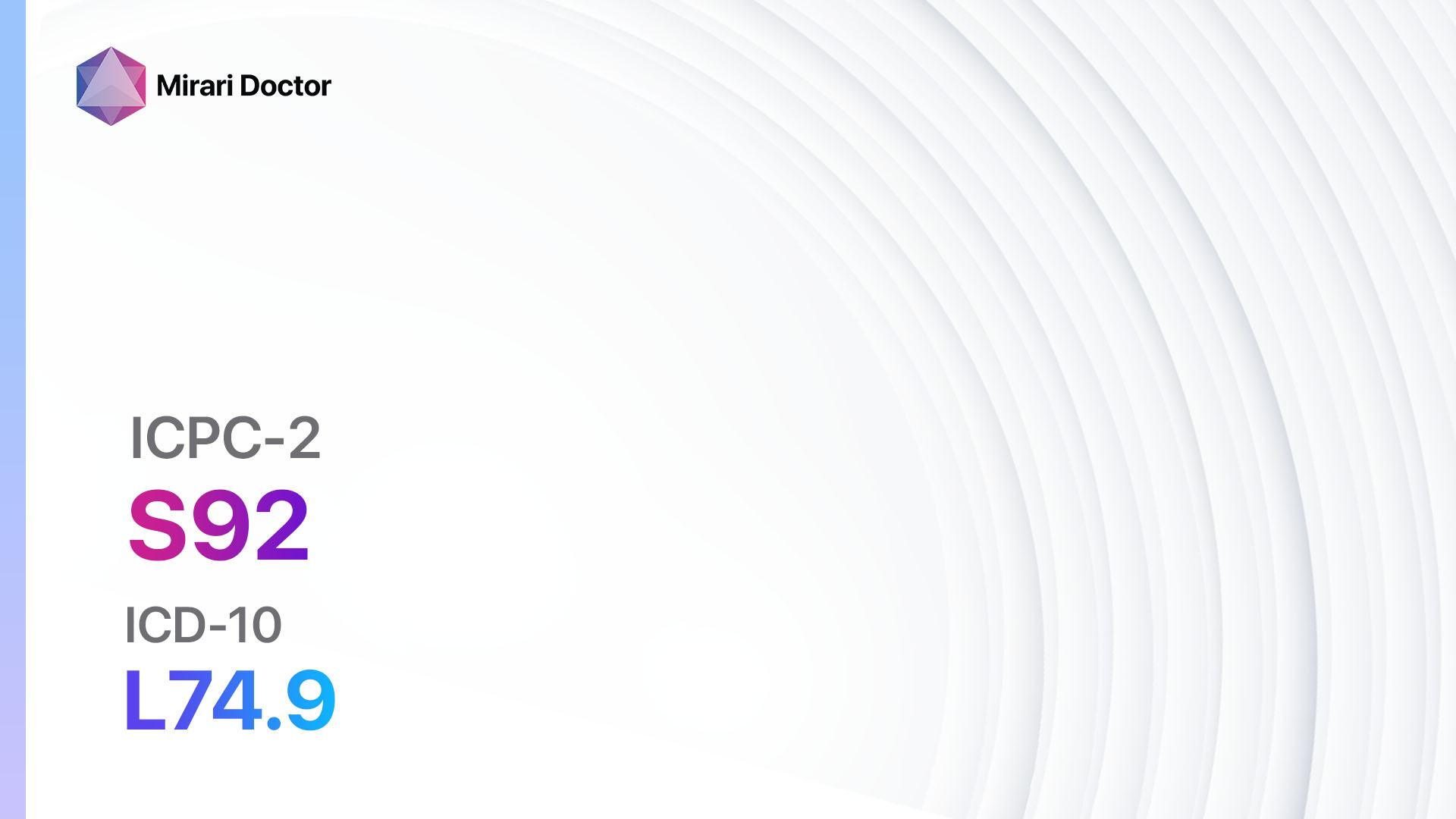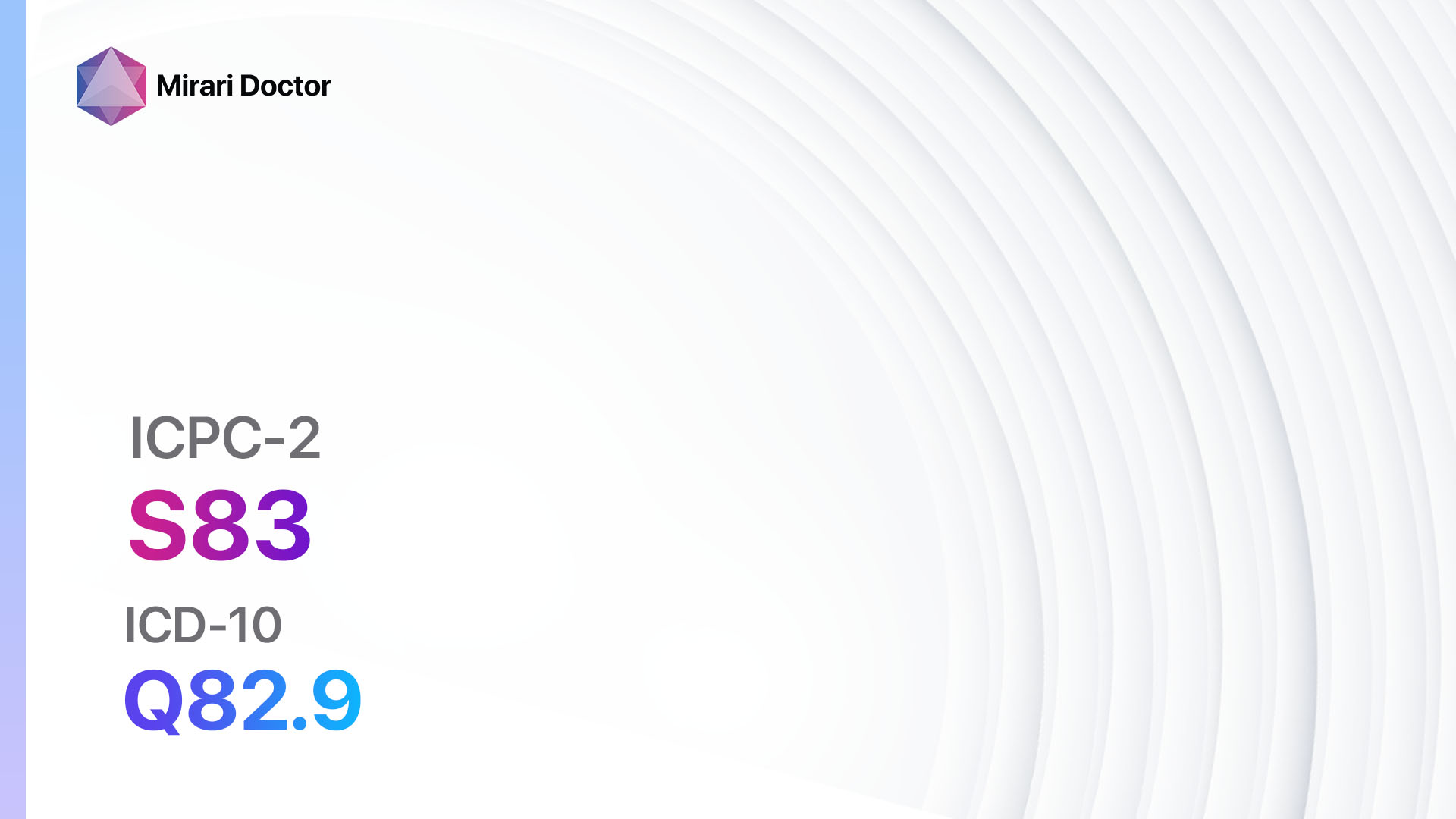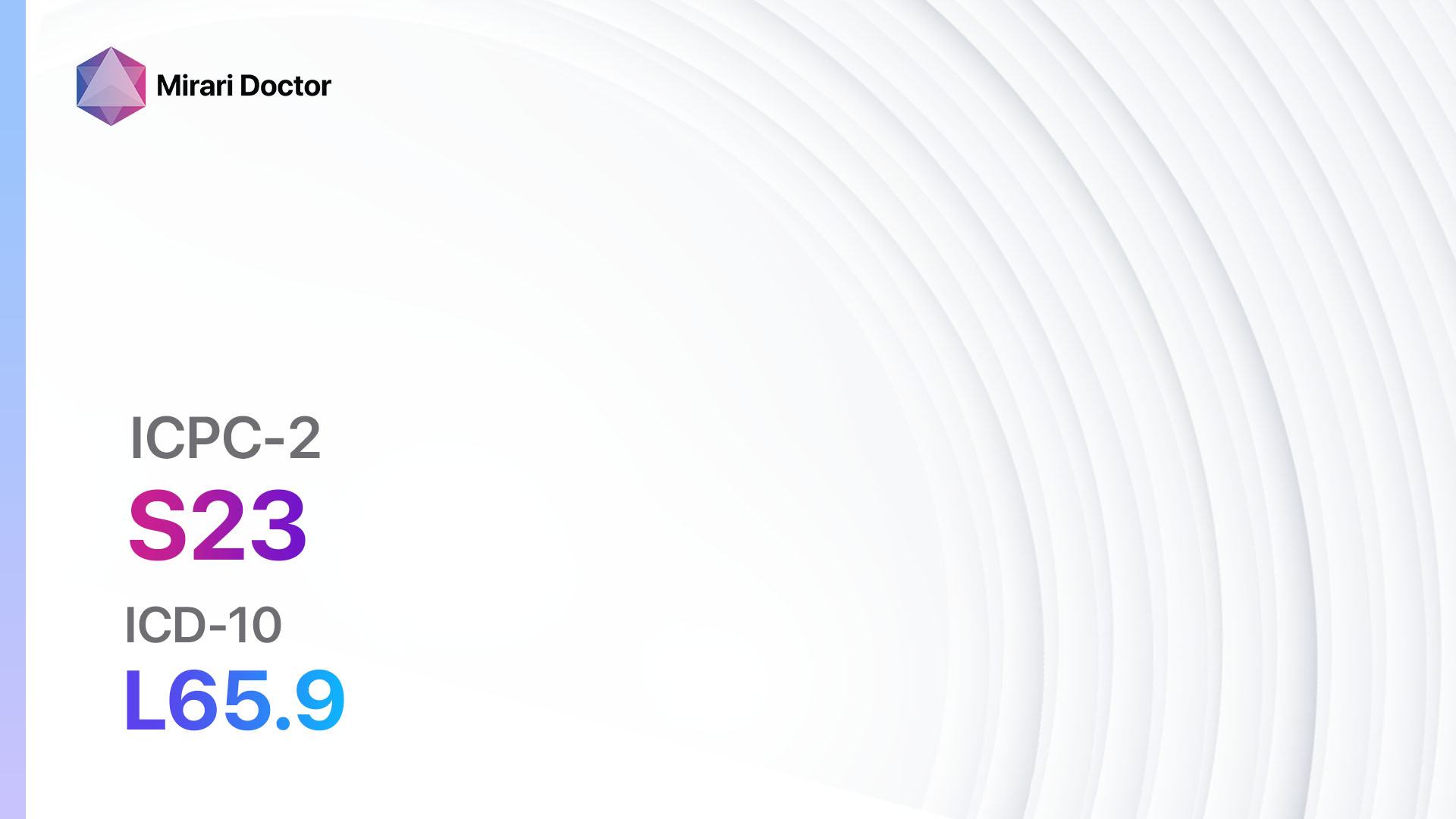
Introduction
Molluscum contagiosum is a common viral skin infection that causes small, raised bumps on the skin. It is caused by the molluscum contagiosum virus (MCV) and is highly contagious.[1] The aim of this guide is to provide a comprehensive overview of the symptoms, causes, diagnostic steps, possible interventions, and lifestyle interventions for molluscum contagiosum.
Codes
Symptoms
- Small, flesh-colored or pink bumps on the skin[2]
- Bumps have a dimple or central indentation[3]
- Bumps may be itchy or tender[4]
- Bumps can appear anywhere on the body, including the face, neck, arms, and genitals[5]
- Bumps may spread to other areas of the body through scratching or contact[6]
Causes
- Direct skin-to-skin contact with an infected person[7]
- Contact with contaminated objects, such as towels or clothing[8]
- Sexual contact with an infected person (genital molluscum contagiosum)[9]
Diagnostic Steps
Medical History
- Gather information about the patient’s symptoms, including the appearance and location of the bumps, any associated itching or tenderness, and any recent exposure to infected individuals or contaminated objects.
- Ask about the patient’s sexual history, if applicable, to determine the possibility of genital molluscum contagiosum.
Physical Examination
- Perform a thorough examination of the skin, paying close attention to the appearance and location of the bumps.
- Look for characteristic features of molluscum contagiosum, such as the central indentation or dimple on each bump.
- Check for signs of secondary infection, such as redness, swelling, or pus.
Determine Severity
- Classify the disease based on severity and depth, if applicable:
- Mild: Fewer than 10 bumps, no signs of secondary infection
- Moderate: 10-50 bumps, possible signs of secondary infection
- Severe: More than 50 bumps, widespread distribution, signs of secondary infection[10]
Laboratory Tests
- No specific laboratory tests are required for the diagnosis of molluscum contagiosum. The diagnosis is primarily based on the characteristic appearance of the bumps.
Diagnostic Imaging
- No diagnostic imaging is necessary for the diagnosis of molluscum contagiosum.
Other Tests
- No other diagnostic tests are necessary for the diagnosis of molluscum contagiosum.
Follow-up and Patient Education
- Schedule a follow-up appointment to monitor the progression of the disease and assess the effectiveness of interventions.
- Educate the patient about the contagious nature of molluscum contagiosum and the importance of avoiding direct skin-to-skin contact with others, sharing personal items, and scratching the bumps to prevent spread and secondary infection.
Possible Interventions
Traditional Interventions
Medications:
Top 5 drugs for Molluscum contagiosum:
- Imiquimod (Aldara):
- Cost: $100-$200 for a 12-week treatment course.
- Contraindications: Hypersensitivity to imiquimod or any component of the cream.
- Side effects: Local skin reactions, such as redness, itching, and burning.
- Severe side effects: None reported.
- Drug interactions: None reported.
- Warning: Avoid contact with eyes, lips, and nostrils.
- Podofilox (Condylox):
- Cost: $100-$200 for a 12-week treatment course.
- Contraindications: Hypersensitivity to podofilox or any component of the solution.
- Side effects: Local skin reactions, such as redness, itching, and burning.
- Severe side effects: None reported.
- Drug interactions: None reported.
- Warning: Avoid contact with eyes, lips, and nostrils.
- Tretinoin (Retin-A):
- Cost: $50-$100 for a 12-week treatment course.
- Contraindications: Hypersensitivity to tretinoin or any component of the cream.
- Side effects: Local skin reactions, such as redness, peeling, and dryness.
- Severe side effects: None reported.
- Drug interactions: None reported.
- Warning: Avoid contact with eyes, lips, and nostrils.
- Cantharidin (Cantharone):
- Cost: $100-$200 for a single treatment session.
- Contraindications: Hypersensitivity to cantharidin or any component of the solution.
- Side effects: Local skin reactions, such as blistering and pain.
- Severe side effects: None reported.
- Drug interactions: None reported.
- Warning: Apply only to the affected areas.
- Cryotherapy (Liquid nitrogen):
- Cost: $100-$200 for a single treatment session.
- Contraindications: None reported.
- Side effects: Local skin reactions, such as blistering, redness, and pain.
- Severe side effects: None reported.
- Drug interactions: None reported.
- Warning: Apply only to the affected areas.
Alternative Drugs:
- Salicylic acid: Over-the-counter treatment option for mild cases of molluscum contagiosum.
- Tea tree oil: Natural remedy with potential antiviral properties.
- Apple cider vinegar: Home remedy that may help dry out the bumps.
- Iodine: Topical antiseptic that can be applied to the bumps.
Surgical Procedures:
- No surgical procedures are typically necessary for the treatment of molluscum contagiosum. However, in some cases, a healthcare provider may choose to remove individual bumps using techniques such as curettage or laser therapy.
Alternative Interventions
- Acupuncture: May help improve the immune response and promote healing. Cost: $60-$120 per session.
- Chelation therapy: Controversial treatment involving the administration of chelating agents to remove heavy metals from the body. Cost: $75-$150 per session.
- Hyperbaric oxygen therapy: Involves breathing pure oxygen in a pressurized chamber to enhance the body’s natural healing processes. Cost: $200-$300 per session.
- Herbal supplements: Some herbs, such as tea tree oil and echinacea, may have potential antiviral and immune-boosting properties. Cost: Varies depending on the specific supplement.
Lifestyle Interventions
- Avoid scratching or picking at the bumps to prevent spread and secondary infection.
- Keep the affected areas clean and dry.
- Avoid sharing personal items, such as towels or clothing, with others.
- Practice safe sexual behaviors to reduce the risk of genital molluscum contagiosum.
- Boost the immune system through a healthy diet, regular exercise, and adequate sleep.
It is important to note that the cost ranges provided are approximate and may vary depending on the location and availability of the interventions.
Mirari Cold Plasma Alternative Intervention
Understanding Mirari Cold Plasma
- Safe and Non-Invasive Treatment: Mirari Cold Plasma is a safe and non-invasive treatment option for various skin conditions. It does not require incisions, minimizing the risk of scarring, bleeding, or tissue damage.
- Efficient Extraction of Foreign Bodies: Mirari Cold Plasma facilitates the removal of foreign bodies from the skin by degrading and dissociating organic matter, allowing easier access and extraction.
- Pain Reduction and Comfort: Mirari Cold Plasma has a local analgesic effect, providing pain relief during the treatment, making it more comfortable for the patient.
- Reduced Risk of Infection: Mirari Cold Plasma has antimicrobial properties, effectively killing bacteria and reducing the risk of infection.
- Accelerated Healing and Minimal Scarring: Mirari Cold Plasma stimulates wound healing and tissue regeneration, reducing healing time and minimizing the formation of scars.
Mirari Cold Plasma Prescription
Video instructions for using Mirari Cold Plasma Device – S95 Molluscum contagiosum (ICD-10:B08.1)
| Mild | Moderate | Severe |
| Mode setting: 1 (Infection) Location: 0 (Localized) Morning: 15 minutes, Evening: 15 minutes |
Mode setting: 1 (Infection) Location: 0 (Localized) Morning: 30 minutes, Lunch: 30 minutes, Evening: 30 minutes |
Mode setting: 1 (Infection) Location: 0 (Localized) Morning: 30 minutes, Lunch: 30 minutes, Evening: 30 minutes |
| Mode setting: 2 (Wound Healing) Location: 0 (Localized) Morning: 15 minutes, Evening: 15 minutes |
Mode setting: 2 (Wound Healing) Location: 0 (Localized) Morning: 30 minutes, Lunch: 30 minutes, Evening: 30 minutes |
Mode setting: 2 (Wound Healing) Location: 0 (Localized) Morning: 30 minutes, Lunch: 30 minutes, Evening: 30 minutes |
| Mode setting: 10 (Dermatitis/Fungus) Location: 0 (Localized) Morning: 15 minutes, Evening: 15 minutes |
Mode setting: 10 (Dermatitis/Fungus) Location: 0 (Localized) Morning: 30 minutes, Lunch: 30 minutes, Evening: 30 minutes |
Mode setting: 10 (Dermatitis/Fungus) Location: 0 (Localized) Morning: 30 minutes, Lunch: 30 minutes, Evening: 30 minutes |
| Total Morning: 45 minutes approx. $7.50 USD, Evening: 45 minutes approx. $7.50 USD |
Total Morning: 90 minutes approx. $15 USD, Lunch: 90 minutes approx. $15 USD, Evening: 90 minutes approx. $15 USD |
Total Morning: 90 minutes approx. $15 USD, Lunch: 90 minutes approx. $15 USD, Evening: 90 minutes approx. $15 USD |
| Usual treatment for 7-60 days approx. $105 USD – $900 USD | Usual treatment for 6-8 weeks approx. $1,890 USD – $2,520 USD |
Usual treatment for 3-6 months approx. $4,050 USD – $8,100 USD
|
 |
|
Use the Mirari Cold Plasma device to treat Molluscum contagiosum effectively.
WARNING: MIRARI COLD PLASMA IS DESIGNED FOR THE HUMAN BODY WITHOUT ANY ARTIFICIAL OR THIRD PARTY PRODUCTS. USE OF OTHER PRODUCTS IN COMBINATION WITH MIRARI COLD PLASMA MAY CAUSE UNPREDICTABLE EFFECTS, HARM OR INJURY. PLEASE CONSULT A MEDICAL PROFESSIONAL BEFORE COMBINING ANY OTHER PRODUCTS WITH USE OF MIRARI.
Step 1: Cleanse the Skin
- Start by cleaning the affected area of the skin with a gentle cleanser or mild soap and water. Gently pat the area dry with a clean towel.
Step 2: Prepare the Mirari Cold Plasma device
- Ensure that the Mirari Cold Plasma device is fully charged or has fresh batteries as per the manufacturer’s instructions. Make sure the device is clean and in good working condition.
- Switch on the Mirari device using the power button or by following the specific instructions provided with the device.
- Some Mirari devices may have adjustable settings for intensity or treatment duration. Follow the manufacturer’s instructions to select the appropriate settings based on your needs and the recommended guidelines.
Step 3: Apply the Device
- Place the Mirari device in direct contact with the affected area of the skin. Gently glide or hold the device over the skin surface, ensuring even coverage of the area experiencing.
- Slowly move the Mirari device in a circular motion or follow a specific pattern as indicated in the user manual. This helps ensure thorough treatment coverage.
Step 4: Monitor and Assess:
- Keep track of your progress and evaluate the effectiveness of the Mirari device in managing your Molluscum contagiosum. If you have any concerns or notice any adverse reactions, consult with your health care professional.
Note
This guide is for informational purposes only and should not replace the advice of a medical professional. Always consult with your healthcare provider or a qualified medical professional for personal advice, diagnosis, or treatment. Do not solely rely on the information presented here for decisions about your health. Use of this information is at your own risk. The authors of this guide, nor any associated entities or platforms, are not responsible for any potential adverse effects or outcomes based on the content.
Mirari Cold Plasma System Disclaimer
- Purpose: The Mirari Cold Plasma System is a Class 2 medical device designed for use by trained healthcare professionals. It is registered for use in Thailand and Vietnam. It is not intended for use outside of these locations.
- Informational Use: The content and information provided with the device are for educational and informational purposes only. They are not a substitute for professional medical advice or care.
- Variable Outcomes: While the device is approved for specific uses, individual outcomes can differ. We do not assert or guarantee specific medical outcomes.
- Consultation: Prior to utilizing the device or making decisions based on its content, it is essential to consult with a Certified Mirari Tele-Therapist and your medical healthcare provider regarding specific protocols.
- Liability: By using this device, users are acknowledging and accepting all potential risks. Neither the manufacturer nor the distributor will be held accountable for any adverse reactions, injuries, or damages stemming from its use.
- Geographical Availability: This device has received approval for designated purposes by the Thai and Vietnam FDA. As of now, outside of Thailand and Vietnam, the Mirari Cold Plasma System is not available for purchase or use.
References
- Meza-Romero R, Navarrete-Dechent C, Downey C. Molluscum contagiosum: an update and review of new perspectives in etiology, diagnosis, and treatment. Clin Cosmet Investig Dermatol. 2019;12:373-381.
- Chen X, Anstey AV, Bugert JJ. Molluscum contagiosum virus infection. Lancet Infect Dis. 2013;13(10):877-888.
- Hanson D, Diven DG. Molluscum contagiosum. Dermatol Online J. 2003;9(2):2.
- Forbat E, Al-Niaimi F, Ali FR. Molluscum Contagiosum: Review and Update on Management. Pediatr Dermatol. 2017;34(5):504-515.
- Olsen JR, Gallacher J, Piguet V, Francis NA. Epidemiology of molluscum contagiosum in children: a systematic review. Fam Pract. 2014;31(2):130-136.
- Braue A, Ross G, Varigos G, Kelly H. Epidemiology and impact of childhood molluscum contagiosum: a case series and critical review of the literature. Pediatr Dermatol. 2005;22(4):287-294.
- Sladden MJ, Johnston GA. Common skin infections in children. BMJ. 2004;329(7457):95-99.
- Tyring SK. Molluscum contagiosum: the importance of early diagnosis and treatment. Am J Obstet Gynecol. 2003;189(3 Suppl):S12-S16.
- Becker TM, Blount JH, Douglas J, Judson FN. Trends in molluscum contagiosum in the United States, 1966-1983. Sex Transm Dis. 1986;13(2):88-92.
- van der Wouden JC, van der Sande R, van Suijlekom-Smit LW, Berger M, Butler CC, Koning S. Interventions for cutaneous molluscum contagiosum. Cochrane Database Syst Rev. 2017;5(5):CD004767.
Related articles
Made in USA



























